+ Open data
Open data
- Basic information
Basic information
| Entry | Database: EMDB / ID: EMD-20708 | |||||||||
|---|---|---|---|---|---|---|---|---|---|---|
| Title | B-Raf:14-3-3 complex | |||||||||
 Map data Map data | ||||||||||
 Sample Sample |
| |||||||||
 Keywords Keywords | Complex Kinase / SIGNALING PROTEIN | |||||||||
| Function / homology |  Function and homology information Function and homology informationpositive regulation of axon regeneration / CD4-positive, alpha-beta T cell differentiation / CD4-positive or CD8-positive, alpha-beta T cell lineage commitment / negative regulation of synaptic vesicle exocytosis / Signalling to p38 via RIT and RIN / head morphogenesis / ARMS-mediated activation / endothelial cell apoptotic process / myeloid progenitor cell differentiation / SHOC2 M1731 mutant abolishes MRAS complex function ...positive regulation of axon regeneration / CD4-positive, alpha-beta T cell differentiation / CD4-positive or CD8-positive, alpha-beta T cell lineage commitment / negative regulation of synaptic vesicle exocytosis / Signalling to p38 via RIT and RIN / head morphogenesis / ARMS-mediated activation / endothelial cell apoptotic process / myeloid progenitor cell differentiation / SHOC2 M1731 mutant abolishes MRAS complex function / Gain-of-function MRAS complexes activate RAF signaling / negative regulation of fibroblast migration / positive regulation of D-glucose transmembrane transport / establishment of protein localization to membrane / positive regulation of axonogenesis / regulation of T cell differentiation / Negative feedback regulation of MAPK pathway / Frs2-mediated activation / stress fiber assembly / face development / MAP kinase kinase activity / thyroid gland development / synaptic vesicle exocytosis / somatic stem cell population maintenance / positive regulation of peptidyl-serine phosphorylation / MAP kinase kinase kinase activity / negative regulation of endothelial cell apoptotic process / postsynaptic modulation of chemical synaptic transmission / positive regulation of stress fiber assembly / ERK1 and ERK2 cascade / positive regulation of substrate adhesion-dependent cell spreading / substrate adhesion-dependent cell spreading / cellular response to calcium ion / thymus development / animal organ morphogenesis / RAF activation / Spry regulation of FGF signaling / Signaling by high-kinase activity BRAF mutants / MAP2K and MAPK activation / visual learning / cellular response to xenobiotic stimulus / epidermal growth factor receptor signaling pathway / centriolar satellite / long-term synaptic potentiation / Negative regulation of MAPK pathway / Signaling by RAF1 mutants / Signaling by moderate kinase activity BRAF mutants / Paradoxical activation of RAF signaling by kinase inactive BRAF / Signaling downstream of RAS mutants / Signaling by BRAF and RAF1 fusions / T cell differentiation in thymus / T cell receptor signaling pathway / MAPK cascade / regulation of cell population proliferation / presynapse / cell body / scaffold protein binding / negative regulation of neuron apoptotic process / protein phosphorylation / positive regulation of ERK1 and ERK2 cascade / protein kinase activity / non-specific serine/threonine protein kinase / neuron projection / postsynapse / cilium / ciliary basal body / protein serine kinase activity / intracellular membrane-bounded organelle / protein serine/threonine kinase activity / calcium ion binding / positive regulation of gene expression / negative regulation of apoptotic process / glutamatergic synapse / mitochondrion / zinc ion binding / ATP binding / identical protein binding / nucleus / plasma membrane / cytosol / cytoplasm Similarity search - Function | |||||||||
| Biological species |  Homo sapiens (human) / Homo sapiens (human) /  Spodoptera aff. frugiperda 1 BOLD-2017 (butterflies/moths) Spodoptera aff. frugiperda 1 BOLD-2017 (butterflies/moths) | |||||||||
| Method | single particle reconstruction / cryo EM / Resolution: 3.9 Å | |||||||||
 Authors Authors | Kondo Y / Ognjenovic J | |||||||||
| Funding support |  United States, United States,  Canada, 2 items Canada, 2 items
| |||||||||
 Citation Citation |  Journal: Science / Year: 2019 Journal: Science / Year: 2019Title: Cryo-EM structure of a dimeric B-Raf:14-3-3 complex reveals asymmetry in the active sites of B-Raf kinases. Authors: Yasushi Kondo / Jana Ognjenović / Saikat Banerjee / Deepti Karandur / Alan Merk / Kayla Kulhanek / Kathryn Wong / Jeroen P Roose / Sriram Subramaniam / John Kuriyan /   Abstract: Raf kinases are important cancer drug targets. Paradoxically, many B-Raf inhibitors induce the activation of Raf kinases. Cryo-electron microscopy structural analysis of a phosphorylated B-Raf kinase ...Raf kinases are important cancer drug targets. Paradoxically, many B-Raf inhibitors induce the activation of Raf kinases. Cryo-electron microscopy structural analysis of a phosphorylated B-Raf kinase domain dimer in complex with dimeric 14-3-3, at a resolution of ~3.9 angstroms, shows an asymmetric arrangement in which one kinase is in a canonical "active" conformation. The distal segment of the C-terminal tail of this kinase interacts with, and blocks, the active site of the cognate kinase in this asymmetric arrangement. Deletion of the C-terminal segment reduces Raf activity. The unexpected asymmetric quaternary architecture illustrates how the paradoxical activation of Raf by kinase inhibitors reflects an innate mechanism, with 14-3-3 facilitating inhibition of one kinase while maintaining activity of the other. Conformational modulation of these contacts may provide new opportunities for Raf inhibitor development. #1:  Journal: Science / Year: 2019 Journal: Science / Year: 2019Title: Cryo-EM structure of a dimeric B-Raf:14-3-3 complex reveals asymmetry in the active sites of B-Raf kinases Authors: Kondo Y / Ognjenovic J / Banerjee S / Karandur D / Merk A / Kulhanek K / Wong K / Roose JP / Subramaniam S / Kuriyan J | |||||||||
| History |
|
- Structure visualization
Structure visualization
| Movie |
 Movie viewer Movie viewer |
|---|---|
| Structure viewer | EM map:  SurfView SurfView Molmil Molmil Jmol/JSmol Jmol/JSmol |
| Supplemental images |
- Downloads & links
Downloads & links
-EMDB archive
| Map data |  emd_20708.map.gz emd_20708.map.gz | 28.6 MB |  EMDB map data format EMDB map data format | |
|---|---|---|---|---|
| Header (meta data) |  emd-20708-v30.xml emd-20708-v30.xml emd-20708.xml emd-20708.xml | 18 KB 18 KB | Display Display |  EMDB header EMDB header |
| FSC (resolution estimation) |  emd_20708_fsc.xml emd_20708_fsc.xml | 7.2 KB | Display |  FSC data file FSC data file |
| Images |  emd_20708.png emd_20708.png | 58.8 KB | ||
| Filedesc metadata |  emd-20708.cif.gz emd-20708.cif.gz | 7 KB | ||
| Archive directory |  http://ftp.pdbj.org/pub/emdb/structures/EMD-20708 http://ftp.pdbj.org/pub/emdb/structures/EMD-20708 ftp://ftp.pdbj.org/pub/emdb/structures/EMD-20708 ftp://ftp.pdbj.org/pub/emdb/structures/EMD-20708 | HTTPS FTP |
-Validation report
| Summary document |  emd_20708_validation.pdf.gz emd_20708_validation.pdf.gz | 567.4 KB | Display |  EMDB validaton report EMDB validaton report |
|---|---|---|---|---|
| Full document |  emd_20708_full_validation.pdf.gz emd_20708_full_validation.pdf.gz | 567 KB | Display | |
| Data in XML |  emd_20708_validation.xml.gz emd_20708_validation.xml.gz | 9.5 KB | Display | |
| Data in CIF |  emd_20708_validation.cif.gz emd_20708_validation.cif.gz | 12.4 KB | Display | |
| Arichive directory |  https://ftp.pdbj.org/pub/emdb/validation_reports/EMD-20708 https://ftp.pdbj.org/pub/emdb/validation_reports/EMD-20708 ftp://ftp.pdbj.org/pub/emdb/validation_reports/EMD-20708 ftp://ftp.pdbj.org/pub/emdb/validation_reports/EMD-20708 | HTTPS FTP |
-Related structure data
| Related structure data |  6uanMC M: atomic model generated by this map C: citing same article ( |
|---|---|
| Similar structure data | |
| EM raw data |  EMPIAR-10544 (Title: Cryo-EM structure of a dimeric B-Raf:14-3-3 complex reveals asymmetry in the active sites of B-Raf kinases EMPIAR-10544 (Title: Cryo-EM structure of a dimeric B-Raf:14-3-3 complex reveals asymmetry in the active sites of B-Raf kinasesData size: 6.2 TB Data #1: Unaligned multi-frame micrographs of B-Raf:14-3-3 complex [micrographs - multiframe] Data #2: Unaligned multi-frame micrographs of B-Raf:14-3-3 complex [micrographs - multiframe]) |
- Links
Links
| EMDB pages |  EMDB (EBI/PDBe) / EMDB (EBI/PDBe) /  EMDataResource EMDataResource |
|---|---|
| Related items in Molecule of the Month |
- Map
Map
| File |  Download / File: emd_20708.map.gz / Format: CCP4 / Size: 30.5 MB / Type: IMAGE STORED AS FLOATING POINT NUMBER (4 BYTES) Download / File: emd_20708.map.gz / Format: CCP4 / Size: 30.5 MB / Type: IMAGE STORED AS FLOATING POINT NUMBER (4 BYTES) | ||||||||||||||||||||||||||||||||||||||||||||||||||||||||||||||||||||
|---|---|---|---|---|---|---|---|---|---|---|---|---|---|---|---|---|---|---|---|---|---|---|---|---|---|---|---|---|---|---|---|---|---|---|---|---|---|---|---|---|---|---|---|---|---|---|---|---|---|---|---|---|---|---|---|---|---|---|---|---|---|---|---|---|---|---|---|---|---|
| Projections & slices | Image control
Images are generated by Spider. | ||||||||||||||||||||||||||||||||||||||||||||||||||||||||||||||||||||
| Voxel size | X=Y=Z: 1.06 Å | ||||||||||||||||||||||||||||||||||||||||||||||||||||||||||||||||||||
| Density |
| ||||||||||||||||||||||||||||||||||||||||||||||||||||||||||||||||||||
| Symmetry | Space group: 1 | ||||||||||||||||||||||||||||||||||||||||||||||||||||||||||||||||||||
| Details | EMDB XML:
CCP4 map header:
| ||||||||||||||||||||||||||||||||||||||||||||||||||||||||||||||||||||
-Supplemental data
- Sample components
Sample components
-Entire : Ternary complex of B-Raf kinase domain dimer and 14-3-3 dimer
| Entire | Name: Ternary complex of B-Raf kinase domain dimer and 14-3-3 dimer |
|---|---|
| Components |
|
-Supramolecule #1: Ternary complex of B-Raf kinase domain dimer and 14-3-3 dimer
| Supramolecule | Name: Ternary complex of B-Raf kinase domain dimer and 14-3-3 dimer type: complex / ID: 1 / Parent: 0 / Macromolecule list: all |
|---|---|
| Source (natural) | Organism:  Homo sapiens (human) Homo sapiens (human) |
-Macromolecule #1: 14-3-3 zeta
| Macromolecule | Name: 14-3-3 zeta / type: protein_or_peptide / ID: 1 / Number of copies: 2 / Enantiomer: LEVO |
|---|---|
| Source (natural) | Organism:  Spodoptera aff. frugiperda 1 BOLD-2017 (butterflies/moths) Spodoptera aff. frugiperda 1 BOLD-2017 (butterflies/moths) |
| Molecular weight | Theoretical: 28.108514 KDa |
| Sequence | String: MSVDKEELVQ RAKLAEQAER YDDMAAAMKE VTETGVELSN EERNLLSVAY KNVVGARRSS WRVISSIEQK TEGSERKQQM AKEYRVKVE KELREICYDV LGLLDKHLIP KASNPESKVF YLKMKGDYYR YLAEVATGET RNSVVEDSQK AYQDAFEISK A KMQPTHPI ...String: MSVDKEELVQ RAKLAEQAER YDDMAAAMKE VTETGVELSN EERNLLSVAY KNVVGARRSS WRVISSIEQK TEGSERKQQM AKEYRVKVE KELREICYDV LGLLDKHLIP KASNPESKVF YLKMKGDYYR YLAEVATGET RNSVVEDSQK AYQDAFEISK A KMQPTHPI RLGLALNFSV FYYEILNSPD KACQLAKQAF DDAIAELDTL NEDSYKDSTL IMQLLRDNLT LWTSDTQGDG DE PAEGGDN UniProtKB: 14-3-3 protein zeta |
-Macromolecule #2: Serine/threonine-protein kinase B-raf
| Macromolecule | Name: Serine/threonine-protein kinase B-raf / type: protein_or_peptide / ID: 2 / Number of copies: 2 / Enantiomer: LEVO / EC number: non-specific serine/threonine protein kinase |
|---|---|
| Source (natural) | Organism:  Homo sapiens (human) Homo sapiens (human) |
| Molecular weight | Theoretical: 84.781922 KDa |
| Recombinant expression | Organism:  Spodoptera aff. frugiperda 1 BOLD-2017 (butterflies/moths) Spodoptera aff. frugiperda 1 BOLD-2017 (butterflies/moths) |
| Sequence | String: SGMAALSGGG GGGAEPGQAL FNGDMEPEAG AGAGAAASSA ADPAIPEEVW NIKQMIKLTQ EHIEALLDKF GGEHNPPSIY LEAYEEYTS KLDALQQREQ QLLESLGNGT DFSVSSSASM DTVTSSSSSS LSVLPSSLSV FQNPTDVARS NPKSPQKPIV R VFLPNKQR ...String: SGMAALSGGG GGGAEPGQAL FNGDMEPEAG AGAGAAASSA ADPAIPEEVW NIKQMIKLTQ EHIEALLDKF GGEHNPPSIY LEAYEEYTS KLDALQQREQ QLLESLGNGT DFSVSSSASM DTVTSSSSSS LSVLPSSLSV FQNPTDVARS NPKSPQKPIV R VFLPNKQR TVVPARCGVT VRDSLKKALM MRGLIPECCA VYRIQDGEKK PIGWDTDISW LTGEELHVEV LENVPLTTHN FV RKTFFTL AFCDFCRKLL FQGFRCQTCG YKFHQRCSTE VPLMCVNYDQ LDLLFVSKFF EHHPIPQEEA SLAETALTSG SSP SAPASD SIGPQILTSP SPSKSIPIPQ PFRPADEDHR NQFGQRDRSS SAPNVHINCM EPVNIDDLIR DQGFRGDGGS TTGL SATPP ASLPGSLTNV KALQKSPGPQ RERKSSSSSE DRNRMKTLGR RDSSDDWEIP DGQITVGQRI GSGSFGTVYK GKWHG DVAV KMLNVTAPTP QQLQAFKNEV GVLRKTRHVN ILLFMGYSTK PQLAIVTQWC EGSSLYHHLH IIETKFEMIK LIDIAR QTA QGMDYLHAKS IIHRDLKSNN IFLHEDLTVK IGDFGLATVK SRWSGSHQFE QLSGSILWMA PEVIRMQDKN PYSFQSD VY AFGIVLYELM TGQLPYSNIN NRDQIIFMVG RGYLSPDLSK VRSNCPKAMK RLMAECLKKK RDERPLFPQI LASIELLA R SLPKIHRSA(SEP) EPSLNRAGFQ TEDFSLYACA SPKTPIQAGG YGAFPVH UniProtKB: Serine/threonine-protein kinase B-raf |
-Experimental details
-Structure determination
| Method | cryo EM |
|---|---|
 Processing Processing | single particle reconstruction |
| Aggregation state | particle |
- Sample preparation
Sample preparation
| Concentration | 0.2 mg/mL | ||||||||
|---|---|---|---|---|---|---|---|---|---|
| Buffer | pH: 8 Component:
| ||||||||
| Grid | Model: Quantifoil R1.2/1.3 / Material: COPPER / Mesh: 200 / Support film - Material: CARBON / Support film - topology: HOLEY / Pretreatment - Type: PLASMA CLEANING / Pretreatment - Time: 15 sec. | ||||||||
| Vitrification | Cryogen name: ETHANE / Chamber humidity: 95 % / Chamber temperature: 278 K / Instrument: LEICA EM GP |
- Electron microscopy
Electron microscopy
| Microscope | FEI TITAN KRIOS |
|---|---|
| Image recording | Film or detector model: GATAN K2 SUMMIT (4k x 4k) / Detector mode: SUPER-RESOLUTION / Average electron dose: 50.0 e/Å2 |
| Electron beam | Acceleration voltage: 300 kV / Electron source:  FIELD EMISSION GUN FIELD EMISSION GUN |
| Electron optics | Illumination mode: FLOOD BEAM / Imaging mode: BRIGHT FIELD |
| Experimental equipment |  Model: Titan Krios / Image courtesy: FEI Company |
 Movie
Movie Controller
Controller




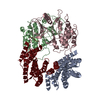

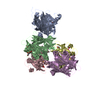
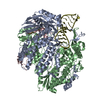
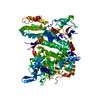
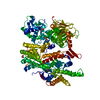







 Z (Sec.)
Z (Sec.) Y (Row.)
Y (Row.) X (Col.)
X (Col.)






















